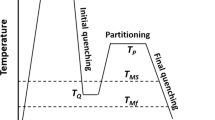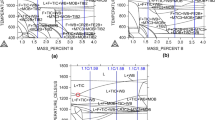Abstract
When aged for long times at elevated temperatures, Fe-12Cr steels can experience a significant decrease in the fracture toughness, as observed by an increase in the fracture appearance transition temperature (FATT). The mechanism responsible for this decrease in toughness has never been unequivocally explained, but it has been generally attributed to the precipitation of second phases or impurity segregation. The objective of this study was to characterize the microstructural changes in conventional and super clean, electroslag remelted (high-purity) M152 steel aged between 616 K and 783 K up to 50 K hours for correlation to the toughness behavior. Analytical electron microscopy techniques were used to characterize the microstructure and impurity segregation. After aging at 727 K, conventional M152 contained large quantities of alpha prime (Cr-rich, bcc structure) in addition to Cr-rich M23C6 carbides and complex Cr-Fe-Mo-Ni-Si-rich precipitates. High-purity M152 aged at 727 K had a similar microstructure as the conventional material, except for the absence of the Si-rich precipitates. Aging at 616 K revealed the same phases as in the as-tempered material. Aged conventional M152 possessed segregated Sn on the prior austenitic grain boundaries, with equivalent levels of P segregation in both the conventional and high-purity materials. A “deembrittling” treatment of 873 K for 2 hours restored much of the original toughness, correlated with a decrease in hardness and a reduction in the amount of alpha prime phase. These results reveal that the degradation in toughness of M152 upon aging up to ∼753 K is primarily due to the combination of alpha prime formation and Sn segregation. These results are consistent with temper embrittlement mechanisms, where impurity segregation and second-phase formation synergistically embrittle NiCr steels. Improvements in the long-term aging embrittlement resistance of M152 below 773 K require ultralow levels of embrittling elements, especially Sn, and a reduction in the alloy Cr content to prevent alpha prime formation.
Similar content being viewed by others
References
J.Z. Briggs and T.D. Parker: “The Super 12% Cr Steels,” Climax Molybdenum Co., 1965, p. 16.
S. Mandziej, A.P. von Rosentiel, H. Goretzki, M. Weiss, and B.H. Kolster: Fresenius Z. Anal. Chem., 1987, vol. 329, pp. 335–41.
H. Goretzki, P. von Rosenstiel, and S. Mandziej: Fresenius Z. Anal. Chem., 1989, vol. 333, pp. 451–52.
R. Guillou, M. Guttmann, and P. Dumoulin: Met. Sci., 1980, pp. 63–72.
P. Lemble, A. Pineau, J.L. Castagne, P. Dumoulin, and M. Guttmann: Met. Sci., 1979, pp. 496–502.
K. Sato, I. Kitagawa, K. Soeda, K. Morinaka, and A. Fujita: Proc. Robert I. Jaffee Memorial Symp. on Clean Materials Technology, ASM Materials Week, ASM, Metals Park, OH, 1992, pp. 145–51.
M. Wall, B.C. Edwards, and J.A. Hudson: International Atomic Energy Agency International Working Group on Fast Reactors Specialist Meeting on “Mechanical Properties of Structural Materials Including Environmental Effects,” Chester, Oct. 10–14, 1983.
J.W. Schinkel, P.L.F. Rademakers, B.R. Drenth, and C.P. Scheepens: Ferritic Steels for High-Temperature Applications, ASM, Metals Park, OH, 1982, pp. 131–49.
C. Berger, E. Potthast, R. Bauer, and G.A. Honeyman: 11th Int. Forgemasters Meeting, Terni/Spoleto, Italy, June 1991.
Y. Hosoi, N. Wade, S. Kunimitsu, and T. Urita: J. Nucl. Mater., 1986, vols. 141–143, pp. 461–67.
R.A. Mulford, C.J. McMahon, D.P. Pope, and H.C. Feng: Metall. Trans. A, 1976, vol. 7A, pp. 1183–95.
U.S. Patent 5,320,687, June 14, 1994.
K. Orita, J. Taira, T. Azuma, Y. Tanaka, and C. Furstoss: Chicago Forging Conf., 1994, pp. 103–08.
I.B. Kim, S.T. Kang, Y.S. Song, J.S. Lee, H.S. Chang, H.M. Kim, M.C. Jeong, and S.J. Kim: 13th Int. Forgemasters Meeting, 1997, vol. 1, pp. 495–502.
A.K. Cianelli, H.C. Feng, A.H. Ucisik, and C.J. McMahon: Metall. Trans. A, 1977, vol. 8A, pp. 1059–61.
R.I. Jaffee, T. Ohhashi, O. Watanabe, and P. Machner: Trans. ISS, 1989, pp. 45–51.
H. Ohtani, H.C. Feng, C.J. McMahon, and R.A. Mulford: Metall. Trans. A, 1976, vol. 7A, pp. 87–101.
V.P. Itkin: Phase Diagrams of Binary Iron Alloys, H. Okamoto, ed., ASM, Metals Park, OH 1993, pp. 102–29.
H.D. Newell: Met. Progr., 1947, pp. 617–26.
J.J. Demo: ASTM STP 619, ASTM, Philadelphia, PA, 1977.
R.M. Fisher, E.J. Dulis, and K.G. Carroll: J. Met., 1953, pp. 690–95.
T.J. Nichol, A. Datta, and G. Aggen: Metall. Trans. A, 1980, vol. 11A, pp. 573–85.
P.J. Grobner: Metall. Trans. A, 1973, vol. 4, pp. 251–60.
Author information
Authors and Affiliations
Rights and permissions
About this article
Cite this article
Angeliu, T., Hall, E.L., Larsen, M. et al. The long-term aging embrittlement of Fe-12Cr steels below 773 K. Metall Mater Trans A 34, 927–934 (2003). https://doi.org/10.1007/s11661-003-0223-9
Received:
Issue Date:
DOI: https://doi.org/10.1007/s11661-003-0223-9




